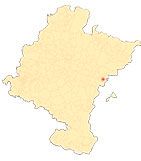Javier, a castle for a saint
Chapel of Santo Cristo (15th century)
The fourth gate that had to be passed through to enter the castle is located at the end of the parade ground and is preceded by an original staircase with worn steps, a solemn circular base and a straight section at the end. The doorway, with a semicircular arch and protected by a machicolation and arrow slits, preserves the original iron-plated gate. It leads to a reception hallway, which on the left opens onto the conference room Grande, while on the right it communicates with the Santo Cristo chapel, which gives its name to the tower in which it is located.
The initial use of the tower when it was built in the 13th century is unknown. The initiative for the creation of the chapel, due to the aesthetics and chronology of its elements, must be attributed to the reforms carried out by Juan de Jaso, father of Saint Francis Xavier, at the end of the 15th century and beginning of the 16th century. The chapel is presided over by the Santo Cristo de Javier, which is an image from the end of the 15th century, although the smile on its face and its rigidity have led to it being erroneously placed in the 13th century, in the transition from Romanesque to Gothic. However, the perfectly vertical body, the slightly raised arms, the hands that close over the nails, the feet practically keeping the axis, the frontal head slightly inclined to the right and, especially, the shape of the cloth of purity (short, tight around the hips and with the right side crossed and with a central vertical fall) make it similar to other Spanish crucifixes from the last two decades of the 15th century (Sigena, Poor Clares of Palencia).
In the 1970s the baroque decoration and paintings of the chapel were removed and the original frescoes were uncovered. Christ is surrounded by an impressive set of late Gothic wall paintings. On its sides are the attributes of the Passion. The side walls depict the Dance of Death, the only example of the topic known in Spain. Several skeletons depict the supremacy of death, the brevity of life and the vanity of worldly things. Although it is a purely medieval topic , it is represented with some formal features that herald Renaissance painting, such as the perspective of the stage that supports the figures and the presence of balusters.












